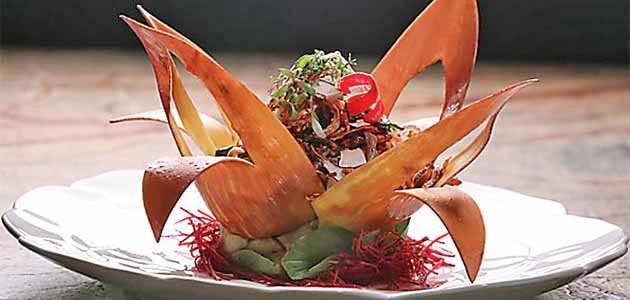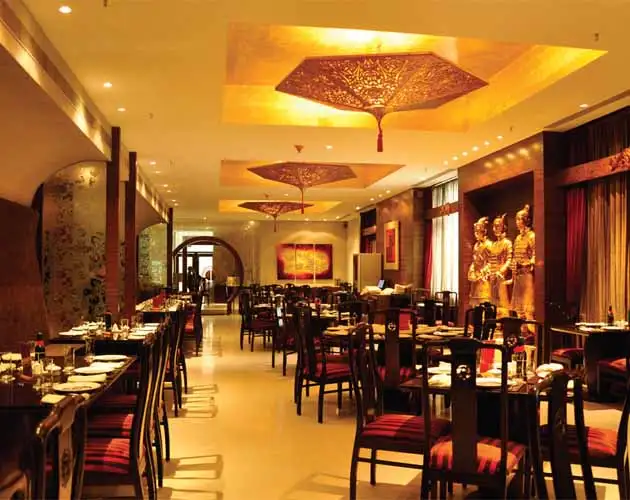
POH is the brain child of Avik Chatterjee, son of restaurateur Anjan Chatterjee. Avik says “a certain segment of younger diners is ready for experimentation and quality.
There’s Alaskan crab leg with tobanjan aioli, dotted with tobiko (fish roe) adding a salty bite to the sweetness of the crab meat. A carpaccio of scallops comes dressed with Thai green curry oil, the gyoza is filled with creamy lamb brain, tenderloin salad has local meat rendered in such a way that it matches wagyu and, there’s top-quality sashimi at the omakase bar that you could eat at Wasabi or any top Japanese restaurant in a five-star at twice the price.
The sashimi — fatty tuna, lean tuna, hamachi and braised eel — comes with homemade soy sauce that has been fermenting in the kitchen for two months (because regular soy out of bottles is too salty and overpowering). It’s this attention to detail, not to mention Chef Vikramjit Roy’s unique flair at combining familiar Asian flavours in unexpected ways that makes POH an undoubted gourmet destination distinct from the casual Asian cafes and bars around us.

Crispy Banana Blossom salad at POH
However, its significance lies in being more than just a very fine restaurant. The next few months are likely to see some of India’s culinary legends navigate new restaurateuring formats. The Taj’s former top chef, Hemant Oberoi, has already opened his eponymous fine-dining restaurant at BKC in Mumbai. The buzz is that his former colleague Anand Solomon too is readying to roll out an independent Thai restaurant in the city. Then, Rahul Akerkar, who had to unceremoniously give up his company and brand Indigo, is said to have finalised the plan (and name) for his new restaurant. Roy, who used to work at Tian at ITC Maurya in Delhi before he made the leap into the challenging realm of standalones, is much younger but no less acclaimed.
It will be interesting to see how he works the market for fine dining in the standalone space, where top quality food and (hopefully) a discerning audience that is not too price sensitive set the tone of the restaurant. If POH is going to show us whether the Indian restaurant scene is finally evolving to a level where top chefs can profitably helm class restaurants without diluting either price points or positioning, what it also represents is a significant new direction for Asian food in the country. As a category, Asian dining till now has been defined by comfort bites served in casual formats.

Caramel and Chocolate
Street foods from Southeast Asia and pop Americanised-Japanese, familiar to a younger audience that has studied or travelled abroad, have been trending in cafes and bars. It will be interesting to see how these flavours are fashioned into cutting-edge gastronomy fare. Avik Chatterjee, whose brainchild is POH, is all of 25 years old. The son of veteran restaurateur Anjan Chatterjee, he roped in Roy for this venture, because he says “there is a certain segment of younger diners ready for such experimentation and quality. Mumbai is also the right place for a product like this”. The most expanded restaurant brands in the country. As India’s only publicly listed restaurant company, the group has tapped a large pool of diners with food that is more familiar than inventive and prices that are strictly affordable. (At Mainland China, the average price per customer, or APC, is currently Rs 750.)
However, now, “we’ve opened a new vertical within the company for the premium segment. Avik kept saying that this is what we should also focus on since the audience’s tastes are changing,” says Chatterjee senior, adding that the company’s aim is to dominate the entire Asian segment. This move by one of the biggest restaurant companies in India reflects not just the changing tastes but the very journey of Chinese/Asian food — from Chinjabi to chic! Chinese Checkers Almost two decades ago, in the mid-1990s, Anjan Chatterjee, then more an adman than restaurateur, sought to redefine Chinese restaurants in the country. Indian-Chinese that had grown out of Kolkata, home to Hakka immigrants, had, of course, become hugely popular in the preceding decades. While old fashioned restaurants in Kolkata, Delhi and Mumbai continued to serve greasy, saucy versions of the immigrant food, inventions like the Manchurian had gained ground.
Mumbai restaurateurs like Nelson Wang and Baba Ling, who dished out golden fried prawns, fried corn cream and many of Indian-Chinese’s best-loved dishes, were well-known enough to be regarded as the first of our restaurant celebrities. However, no one had thought of building a national chain of Chinese restaurants. This is what Chatterjee aspired to do with Mainland China. From day one, I knew I wanted a national chain.

Lamb foie gras goyoza
That is why after opening the first outlet in Mumbai, we immediately went to Bengaluru,¨ he says. The brand was modelled on PF Chang’s China Bistro, one of the most expanded chains of full-service restaurants in the world (it has more than 200 outlets today), and tried to break away from Indian-Chinese staples by trying to acquaint Indian diners with regional Chinese food. For the first time, people (in a standalone) were being told about Cantonese vs Sichuan, and offered full-fledged dim sum menus and Peking duck. The brand was pegged as ¡§affordable luxury and grew to become India’s most popular branded chain of restaurants. Speciality Restaurants went public in 2012.
There was pressure to rapidly expand the brand (by then, it had 48 outlets across the country) but the next few years saw slipups, partly because it spread itself too thin but also because India’s tastes were rapidly changing. While diners were evolving in the metros, and a brand that was relevant in the late 1990s clearly needed overhauling, in smaller, tier-3 cities, people remained isolated from the highs and lows of global food-dom. Surprisingly, Mainland China did not find the acceptance that it had banked on in some of these small towns like Durgapur, Chatterjee acknowledges.
Now, as it is right-sizing (three outlets have been shut) and readying for a makeover (most outlets will convert to a new brand called Mainland China Asia Kitchen, to serve up not just Chinese but pan-Asian food, in accordance with the preference of the audience), a new front has been opened: Aspirational Asian. We still have Rs 70-80 crore in the bank from the IPO and are debt-free. But we are careful with projections and taking it slow and steady,¨ says Chatterjee.

If Mainland China was modelled on PF Chang’s, POH seems to take its inspiration (if not in food, then in its positioning) from Zuma. The Japanese and Asian-inspired izzakaya-style restaurant brand has seen spectacular success in the last decade, expanding from its flagship London Knights bridge outlet to the Middle East, America and Bangkok (10 outlets in all), and attracting society A-listers at all these spots. In Mumbai, where food and a fashionable lifestyle perhaps mix better than in any other Indian city, it will be interesting to see how POH’s positioning works. Changing Formats The current popularity of pan-Asian flavours is in keeping with global trends.
In the last 15 years, Asian food has gone from being a fad with limited appeal in America and Europe to becoming one of the most popular cuisines around. A Euromonitor report, for instance, studied global sales at Asian fast food restaurants and found these to have grown nearly 500% since 1999 the fastest growth for any food category anywhere in the world. In India, our history of Indian-Chinese and comfort with bold flavours meant that pan-Asian was a natural go-to option for diners and restaurateurs alike.
The spurt in casual cafes and bars (many are now chains growing rapidly) serving this type of food has been incredible since 2012 with home-grown brands in Delhi, Mumbai and Bengaluru serving up everything from trendy baos to lettuce-wrapped minced chicken, and other pop dishes of casual dining in America. Five years into our own pan-Asian revolution, the race is now on to find newer restaurant formats in this genre.

If POH is pegged as a chef-led luxury space (APC: Rs 2,000), another new format some players are trying out is the shophouse. Shophouse, of course, refers to the cheap, family-owned restaurants most famously found in Bangkok. These range from curry and-rice restaurants where curries are pre-cooked and ladled out over bowls of rice at lunch when you point out your preference to places where bowl meals can be customised from a host of raw ingredients on display. Chipotle’s, the quick service chain of Mexican restaurants in the US, whose phenomenal success all aspired to ape (before a public health scare dented its reputation), opened its Southeast Asian casual dining brand, ShopHouse Southeast Asian Kitchen, in 2011.
The premise was simple ¡X quick and relatively nutritious fast food that could be customised in bowls from a host of ingredients, including sauces made from scratch. The brand never took off and this year Chipotle¡¦s shut it down. Regardless of the global failure of shophouse as organised restaurant retail, a handful of Indian restaurant companies are hoping to make the format work and shophouse restaurants have come up in Delhi and Mumbai.
The jury is still out on them. Then, there are small restaurants dedicated to specialised cuisines such as Vietnamese, Thai and Korean. Often chef-run, these build on an intimate experience with fresh food cooked in open kitchens, and keep their pricing low. With more Indians now accepting regional Asian flavours instead of just Chinese, these restaurants are raising the bar, relying on volumes and takeaways to make their numbers. We will see more of these in the future.
That the Asian space can have both these small ventures and ambitious, cutting-edge spaces like POH point to India’s enduring love affair with noodles and soy and everything in between.







